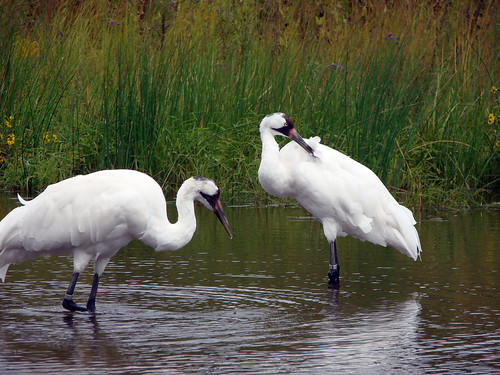 |
| I'm not sure which individuals this crane pair is, but they were photographed at the International Crane Foundation in 2007. |
In 1967, a female Whooping Crane named Tex was hatched at the San Antonio Zoo. Normal zoo protocol with birds that imprint is to leave hatchlings with their parents, but Tex had life-threatening health problems and needed to be cared for by humans.
At the time, there were only 109 Whooping Cranes left in the entire world, most in captivity. The survival of each one was important, but even more important if the species was to be pulled from the brink of extinction was ensuring that every possible individual was reproducing.
Researchers hoped against hope that Tex would figure out that she was a Whooping Crane, not a person, and the U.S. Fish and Wildlife Service transferred her to the Patuxent Center, putting some of the top crane biologists on the case. Even though they couldn’t get her to accept a crane mate, they tried artificial insemination, but without her performing the crane courtship dances with a bird she’d forged a pair bond with, she could not ovulate—she physiologically needed a mate who looked like one of the people who raised her. That’s what imprinting is: species that imprint become fixated on how the birds raising them look and move and vocalize, and that becomes their standard for what they need in a mate. The old song “I Want a Gal Just Like the Gal That Married Dear Old Dad” could have been written by an imprinted bird.
Two young college graduates, George Archibald and Ron Sauey, started the International Crane Foundation (ICF) in 1973, their goal to help all 15 of the world’s crane species, some which were on the brink of extinction. They had no real track record, but when Archibald came up with an idea for getting an imprinted crane to breed by setting himself up as Tex’s mate and artificially inseminating her with crane semen, the US Fish and Wildlife Service, at their wits’ end, decided it was worth a try and transferred her to ICF just before cranes would be getting romantic before the spring of 1976.
George set up a desk and cot alongside her enclosure and stayed with her pretty much 24-7 to establish a pair bond with her, including flapping his arms and jumping in as close an approximation of the Whooping Crane dance as a human being can muster. She took to him quickly. He recalled in an interview with Dianna Wray for a February 2020 article in Houstonia, “It was very easy, because nobody had ever paid attention to her before, since they were trying to get her to connect with one of the cranes. When I paid attention, she finally had her human.”
Although Tex bonded with Archibald, not much happened that year, but in 1977, following the same protocol, Tex laid her first egg. Tragically, it was infertile. She was 10 years old—in the prime of life.
In 1978, again dancing with George who again artificially inseminated her, Tex laid another egg. This time it was fertile, but the chick within died just before hatching. In 1979, her egg had too soft a shell and broke. Year after year they tried, and failed, to help Tex produce a chick. Finally, in 1982, when she was 15, she again laid a fertile egg.
Biologists swapped her own egg with a Sandhill Crane egg and they hatched her real egg in an incubator. It had a slightly wrinkled end that had to be moistened a lot to keep from dehydrating. And when the chick hatched, with human assistance, on June 1, the chick was small and wouldn’t eat. They had to feed it via a tube down its tiny throat to get food into its crop. With that, the little guy sprung to life. ICF staff named him “Gee Whiz,” partly because of their delight that Tex had finally succeeded but mostly after George Gee at Patuxent, who had done much of the leading research on captive cranes and was the scientist who collected the crane semen used for artificially inseminating Tex.
This was such thrilling international news that George Archibald was invited to appear on The Tonight Show on June 23, when Gee Whiz was 3 weeks old. But late the night before his appearance, not long after he’d flown from Wisconsin to California, raccoons broke into the pens at ICF and killed Tex. I was close friends with Ron Sauey, co-founder of ICF, and that fall when he was invited to speak at Hawk Ridge, he stayed with Russ and me, so I got to hear first-hand just how devastated everyone was about it.
Like his mother Tex as a chick, Gee Whiz needed a lot of tender loving care. Unlike his mother, he didn’t end up all that enamored of humans and was fiercely territorial regarding his enclosure and his mate—most of the crane handlers at ICF dreaded working with him because he knew just where to bite to inflict the most pain. He had a mate, Oobleck, but fathered over his long life a total of at least 178 Whooping Cranes—far more than one female could produce—thanks to artificial insemination projects. As of 2018, 9 of Gee Whiz’s offspring were still alive in captivity and 29 in the wild, some breeding in Wisconsin.
Gee Whiz died on February 24 at the ripe old age of 38. I suspect even the crane handlers are missing him.